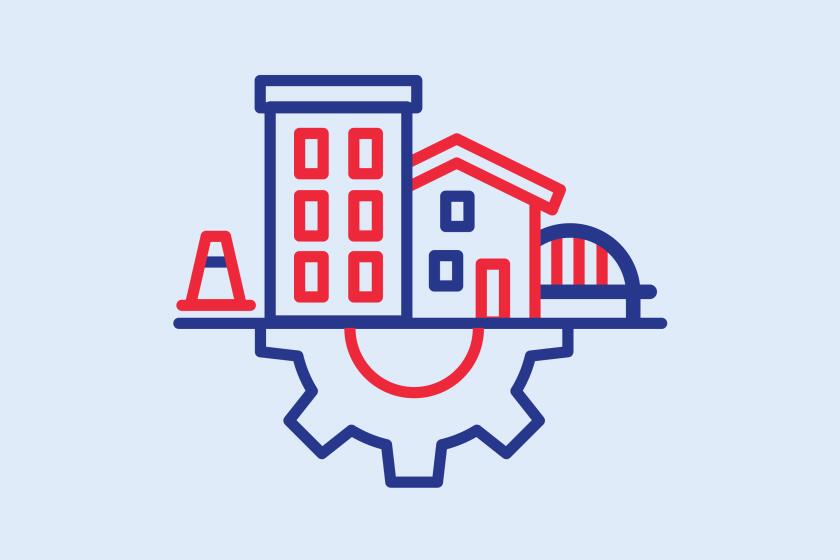Prop. 5 could unleash a flood of new affordable housing, road repairs, fire stations — and tax hikes

- Share via
Money for new fire stations, repaved roads, renovated libraries and more is on the ballot in the city of Santa Clara next month. Voters in the Silicon Valley suburb of 127,000 will decide if they’ll pony up for a $400-million bond measure to finance the improvements.
Californians have made hundreds of decisions like these over the decades, but this time there’s a twist. No one knows how many votes it will take to win.
The uncertainty comes from a quirk of California’s complicated electoral system. In years past, local bond campaigns like Santa Clara’s Measure I needed two-thirds support for passage. Now, a statewide ballot measure, Proposition 5, may change that.
If approved by a majority of California voters, Proposition 5 would decrease the approval threshold for local bonds from two-thirds to 55%, making it easier to fund low-income housing, expand roads and transit, renovate parks and construct other public infrastructure projects.
Should Proposition 5 win, Measure I and 17 other local bond measures on the November ballot would concurrently benefit from the lower threshold. That means their fate could depend not only on local voters but on those across California.
“It is kind of like going down a black hole and holding your breath,” said Santa Clara City Councilmember Karen Hardy, a backer of Measure I.
Proposition 5 will lower the voter threshold required to pass local affordable housing and transportation bond measures.
On its face, Proposition 5 might seem like a dry, bureaucratic change to how communities pay for public improvements. But it has the potential to unleash a flood of new projects — and tax increases to finance them.
Since 2002, local governments and special districts in California have put 151 bond measures before voters, according to Michael Coleman, a municipal finance consultant who tracks the issue. Just more than half passed, securing the two-thirds margin necessary. Had 55% instead been the threshold, 86% of the bond measures would have been approved.
“It would have been a huge difference,” Coleman said.
Should Proposition 5 pass, Coleman expects that many more local governments will bring bonds to the ballot. They’re one of the few ways to increase property taxes — often the revenue source to repay the bonds — given public financing rules inaugurated by the passage of Proposition 13 in 1978. Voters lowered the approval threshold for local school bonds from two-thirds to 55% in 2000, which led to a surge in their introduction and passage.
Supporters of Proposition 5 include labor, affordable housing and local government interests.
John Gioia, a longtime supervisor in Contra Costa County, said the needs of cities and counties are just as great as those of schools. As climate change leads to more frequent and severe natural disasters, local governments will need to find ways to finance clean water, resiliency and sea-level rise projects, he said. Those concerns, he said, only add to the deficits in homeless housing and traditional infrastructure facing communities across the state.
“The cost to do nothing is more than the cost of doing something,” Gioia said.
Real estate interests are leading the opposition to California’s Prop 5 which would make it easier to raise money for affordable housing.
At first, the coalition behind Proposition 5 wanted more expansive changes to taxation policies. State lawmakers, who voted to place Proposition 5 on the ballot, had planned additionally to try to lower the threshold for approving special taxes at the local level from two-thirds to 55%. But they backtracked and limited the proposed changes to bonds.
And proponents of Proposition 5 also hoped the measure would ease the approval of an anticipated affordable housing bond that would have been the largest in state history.
Officials in nine Bay Area counties had pushed for years to get a $20-billion affordable housing bond on the November ballot. But in August, the bond measure was withdrawn, with proponents citing uneven polling and litigation.
The retrenchment doesn’t surprise Susan Shelley, a spokesperson for the Howard Jarvis Taxpayers Assn., the group founded by the author of Proposition 13 and a principal opponent of Proposition 5.
“It’s certainly true that the people of California are feeling squeezed,” Shelley said.
Shelley said that the significance of the change proposed by Proposition 5 shouldn’t be understated. The two-thirds voter threshold for local bond measures was written into California’s Constitution in 1879. Requiring supermajority support restrains politicians from proposing big, fancy projects today that taxpayers will have to pay for decades from now, she said.
“If you have to get a two-thirds vote and you have to get consensus at that level, you have to ask for less or you have to be more focused on what you’re doing,” Shelley said.
Public polling on Proposition 5 has been sparse but points to a tight race. A survey of likely voters last month from the nonpartisan Public Policy Institute of California found 49% in favor of the measure, 50% opposed and 1% undecided, a difference within the poll’s margin of sampling error.
Even some bond supporters are split on the proposition.
Although Hardy, the Santa Clara council member, knows it could benefit the bond proposal she’s behind, she said she’s not sure how she’ll vote on the statewide measure.
Santa Clara needs to upgrade its sewer system and build new fire stations to accommodate larger, modern engines, and the fate of Proposition 5 could determine whether those projects happen, she said. But she worries that lowering the threshold could lead to less crucial bonds in the future.
“From a local point of view, I’m like, gosh, that would be helpful,” Hardy said. “But I can’t make decisions for only the short term.”
More to Read
Sign up for Essential California
The most important California stories and recommendations in your inbox every morning.
You may occasionally receive promotional content from the Los Angeles Times.








